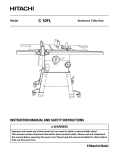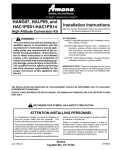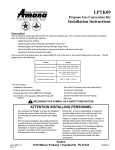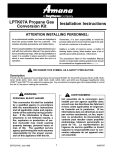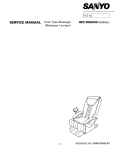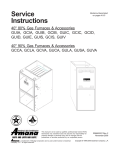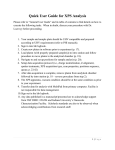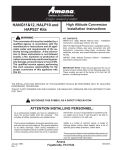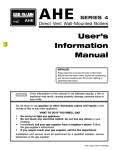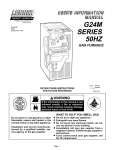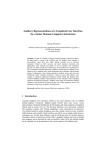Download hang06 halp05 hacips01-10 io manual
Transcript
HANG06, HALP05, & HAC1PS01 thru 10 Kits High Altitude Conversion Installation Instructions ATTENTION INSTALLING PERSONNEL: As a professional installer you have an obligation to know the product better than the customer. This includes all safety precautions and related items. Remember, it is your responsibility to install the product safely and to know it well enough to be able to instruct a customer in its safe use. Prior to actual installation, thoroughly familiarize yourself with this Instruction Manual. Pay special attention to all safety warnings. Often during installation or repair it is possible to place yourself in a position which is more hazardous than when the unit is in operation. Safety is a matter of common sense...a matter of thinking before acting. Most dealers have a list of specific good safety practices...follow them. The precautions listed in this Installation Manual should not supersede existing practices but should be considered as supplemental information. RECOGNIZE THIS SYMBOL AS A SAFETY PRECAUTION. THE INSTALLATION AND SERVICING OF THIS EQUIPMENT SHOULD BE PERFORMED ONLY BY QUALIFIED, EXPERIENCED TECHNICIANS. IN CANADA “THE CONVERSION SHALL BE CARRIED OUT IN ACCORDANCE WITH THE REQUIREMENTS OF THE PROVINCIAL AUTHORITIES HAVING JURISDICTION AND IN ACCORDANCE WITH THE REQUIREMENTS OF THE CAN/CGS B149.1 AND B149.2 INSTALLATION CODE.” WARNING Kit Includes: This conversion kit shall be installed by a qualified agency in accordance with the manufacturer’s instructions and all applicable codes and requirements of the authority having jurisdiction. If the information in these instructions is not followed exactly, a fire, explosion or production of carbon dioxide may result causing property damage, personal injury or loss of life. The qualified service agency performing this work assumes responsibility for the proper conversion of this appliance with this kit. Effective: October 1994 HANG06 (High Altitude Natural Gas) - installation instructions, orifices, wire ties. HALP05 (High Altitude Propane) - installation instructions, propane orifices, valve conversion kits with instructions, conversion rating plate, conversion date certificate, wire ties, and screen/turbulator removal warning tag. HAC1PS** (High Altitude Catagory 1 Pressure Switch) - installation instructions, pressure switch. Amana Refrigeration, Inc. Fayetteville, 1 TN 37334 10759901 I. DESCRIPTION is based on non-derated gas (about 1000 BTU/FT3 for natural gas, and 2500 BTU/Ft3 for propane gas). If your gas supply has been derated for the altitude, contact your gas supplier for orifice sizing. These kits are required when installing Amana Air Command 80 SSE and SV furnaces (GUIA, GCIA, GUIB, and GCIB) at altitudes above 7500 ft. Above this altitude, a derating of the appliance must be followed since the CFM moved by the induced draft and blower fans remain almost constant while the pounds of oxygen in that air is reduced as the altitude increases. If this procedure is not followed and the fuel input is not reduced, combustion can be inefficient, incomplete or can possibly result in premature failure of the heat exchanger due to an excessive temperature rise. Do not derate by adjusting the manifold pressure to a lower pressure reading than what is specified on the furnace nameplate. With a lower density of air and a lower manifold pressure at the burner orifice, the orifice will not aspirate the proper amount of air into the burner. This can cause incomplete combustion of the gas, flashback, and/or possible yellow tipping. In addition to using smaller orifices to reduce the fuel input, a different pressure switch must be used at altitudes above 7500 feet because of the reduced air density. This is required regardless of the heat content of the fuel used. The orifices in the high altitude kits have been selected as a result of testing with the American Gas Association. They will provide appropriate derating at altitudes above 7500 feet for proper furnace performance. The selection Nat. Gas Derates HAC1PS HAC1PS HAC1PS HAC1PS HAC1PS HAC1PS HAC1PS HAC1PS HAC1PS HAC1PS (See Exp. 01 02 03 04 05 06 07 08 09 10 Sec. V) GUIA/B045 7500-9500 ft 9500-11000 ft GUIA/B070 7500-9500 ft 9500-11000 ft GUIA/B090 7500-9500 ft 9500-11000 ft GUIA/B115 7500-9500 ft 9500-11000 ft GUIA/B140 7500-9500 ft 9500-11000 ft GCIA/B045 7500-9500 ft 9500-11000 ft GCIA/B070 7500-9500 ft 9500-11000 ft GCIA/B090 7500-9500 ft 9500-11000 ft GCIA/B115 7500-9500 ft 9500-11000 ft GCIA/B140 7500-9500 ft 9500-11000 ft PRESSURE SW. SETTINGS "W.C. 34±4% 42±4% X X X X 33±4% 41±4% X X 31±4% 38±4% X 27±4% 34±4% X X 25±3% 30±3% X X X 34±4% 42±4% X X 33±4% 41±4% X X 31±4% 38±4% X 27±4% 34±4% X X 25±3% 30±3% X -1.42 -1.30 -1.20 -1.14 -1.10 -1.05 -1.00 -0.95 TABLE 1 - PRESSURE SWITCH KITS (CATEGORY I VENTING ONLY) 2 -0.89 -0.85 II. PRESSURE SWITCH INSTALLATION CAUTION The gas supply must be shut off prior to disconnecting the electrical power, before proceeding with the conversion. 1. Remove pressure switch. (Requires removing two mounting screws, disconnecting rubber hose and disconnecting wiring.) See Fig. 1 for typical location. CAUTION To avoid the risk of fire, property damage, or personal injury, if disconnecting wires on the pressure switch, make certain to reconnect the wires in the same location. FIGURE 2 - GAS MANIFOLD REMOVAL 2. Replace natural gas orifices (Fig. 3A & 3B) with the correct orifice kit depending on propane or natural gas usage and the altitude at the installation site. Refer to Tables 2 or 3 for the appropriate kit required. FIG. 1 - PRESSURE SWITCH FIGURE 3A - REPLACING GAS ORIFICES 2. Install the pressure switch provided in this kit. See Table 1 for the appropriate kit needed. 3. Reconnect the hose. Reconnect all wires. Verify wiring on the wiring diagram located inside the blower compartment access panel. 4. Proceed with orifice installation. FIGURE 3B - ORIFICES III. ORIFICE INSTALLATION CAUTION The gas supply must be shut off prior to disconnecting the electrical power, before proceeding with the conversion. KIT NO. ALTITUDE (ft.) ORIFICE HANG06 7500 to 11000 # 45 Table 2: Natural Gas Orifice Kits* * This table assumes non-derated natural gas (about 1000 Btu/ft3). If your gas supply has been derated for the altitude, contact your gas supplier for orifice sizing. 1. Remove the gas manifold by removing the burner box front cover, cutting the wire ties, disconnecting the gas valve low voltage wires, and removing the four manifold mounting screws. See Figure 2. 3 IV. PROPANE GAS CONVERSION KIT NO. ALTITUDE (ft.) ORIFICE HALP05 7500 to 11000 # 56 WARNING PERSONAL INJURY HAZARD If your propane gas furnace is installed in a basement, an excavated area or a confined space, we strongly recommend that you contact your propane supplier about installing a warning device that would alert you to a gas leak. Table 3: Propane Gas Orifice Kits 4. Tighten orifices with a box-end wrench. Do not use a socket wrench, as it could damage the orifices. Do not overtighten. Do not cross thread. .... Propane gas is heavier than air and any leaking gas can settle in any low areas or confined spaces. CAUTION To prevent premature heat exchanger failure, follow the instructions below to remove all metal inserts from the heat exchanger tubes during propane conversions. .... Propane gas odorant may fade, making the gas undetectable except with a warning device. 5. If converting to propane gas, remove metal screen inserts, where present, from the entrance of the heat exchanger tubes. See Figure 4 and follow the a,b,c directions. An undetected gas leak would create a danger of explosion or fire. If you suspect the presence of gas, follow the instructions on the cover of the furnace installation manual. Failure to do so could result in SERIOUS PERSONAL INJURY OR DEATH. WARNING PERSONAL INJURY HAZARD Iron oxide (rust) can reduce the level of odorant in propane gas. A gas detecting device is the only reliable method to detect a propane gas leak. Contact your propane supplier about installing a gas detecting warning device to alert you in the event that a gas leak should develop. FIGURE 4 - REMOVAL OF METAL SCREEN INSERTS a) Remove entire burner box assembly, including burners, from the partition panel as one unit. Failure to detect a propane gas leak could result in an EXPLOSION or FIRE which could cause SERIOUS PERSONAL INJURY OR DEATH. b) Hold assembly and remove the screen retention plate and tube inserts from each section of the heat exchanger. c) Reinstall the retention plate and entire burner box assembly. CAUTION To prevent unsatisfactory furnace operation, the proper gas conversion kit must be used for each valve. Use the White-Rodgers spring kit only with the White-Rodgers gas valve and use the Honeywell spring kit only with the Honeywell gas valve. THE SPRING KITS ARE NOT INTERCHANGEABLE. 6. Reinstall the gas manifold and reconnect the gas valve low voltage wiring. Install new wire ties making sure that wires do not droop between orifices and burners. 7. If converting to propane gas, see PROPANE GAS CONVERSION section for additional instructions. If remaining on natural gas, skip to OPERATIONAL CHECK. 4 IMPORTANT: Propane gas is heavier than air and does not vent upward as with natural gas fuels. sion kit. If the unit is equipped with a White-Rodgers 36E gas valve, (Figure 5a), use Spring Kit #92-0659 (Figure 5b). If the unit is equipped with a Honeywell VR8205 gas valve, (Figure 6a), use Spring Kit #393691 (Figure 6b). In each case, change the regulator spring per instructions included with that particular regulator spring. Discard whichever spring kits are not used. 1. IMPORTANT: Remove the metal inserts from the entrance of all heat exchanger tubes, as shown in Fig. 4. This should be done as part of the “ORIFICE INSTALLATION” procedure. 2. Replace the gas valve regulator spring with one of two new springs included in this propane gas conver- 3. Attach label shown in Figures 5B or 6B, to gas valve indicating propane conversion. FIGURE 6A HONEYWELL VR8205 GAS VALVE FIGURE 5A WHITE-RODGERS 36E GAS VALVE FIGURE 5B WHITE-RODGERS SPRING KIT FIGURE 6B HONEYWELL SPRING KIT V. OPERATIONAL CHECK 4. CHECK GAS INPUT AND PRESSURES Check inlet gas pressure. With the power and gas off, connect a water manometer or adequate gauge to the “inlet pressure tap” of the gas valve. With the power and gas on, put the furnace into heating cycle and turn on all other gas consuming appliances. For natural gas, the inlet gas pressure should be between 5.0 and 10.0 inches of water. For propane gas the inlet gas pressure should be between 11.0 and 14.0 inches of water. 1. Start the furnace using the procedures in the section, “Operating Your Furnace” in the installation instructions. In addition, perform the following checks and adjustments. 2. The position of the ignitor, relative to the burner, is not effected by this conversion procedure but the ignitor should be visually inspected for any damage at this point. 3. CHECK FOR LEAKS. Leak check the orifice threads by using a soap solution. Reinstall the burner box cover. 5. CHECK THE MANIFOLD PRESSURE A tapped opening (“Manifold Pressure Tap” in Figures 5A or 6A) is provided in the gas valve to facilitate measurement of the manifold pressure. A “U Tube” manometer having a scale range from 0 to 12 inches of water should be used for this measurement. The manifold pressure must be measured with the burners operating and the burner box cover in place. WARNING To avoid the risk of fire or explosion, do not use a flame to check for leaks. 5 7. CHECK THE GAS INPUT - PROPANE GAS Verify the gas input rate by checking that the appropriate orifices have been installed and the manifold pressure has been set as stated in these instructions. To adjust the pressure regulator, remove the adjustment screw or cover on the gas valve. Turn out (counterclockwise) to decrease pressure, turn in (clockwise) to increase pressure. (“Manifold Pressure Adjustment” in Figs. 5A or 6A). Only small variations in gas flow should be made by means of the pressure regulator adjustment. For natural gas, the manifold pressure must be between 3.2 and 3.8 inches water column (3.5” nominal). For propane gas, the manifold pressure must be between 9.7 and 10.3 inches water column (10.0” nominal). Any major changes in flow must be made by changing the size of the burner orifices. 8. CHECK BURNER FLAMES Check burner flames through the view port in the burner box. Flames should be stable, soft and blue, (dust may cause orange tips but they must not be yellow). They should extend directly outward from the burners without curling, floating, or lifting off. 9. Check the normal operating sequence of the ignition system to insure burners light properly. 6. CHECK THE GAS INPUT - NATURAL GAS 10. CHECK TEMPERATURE RISE To measure the gas input using the gas meter, proceed as follows: NOTE: The relationship between external static pressure and temperature rise will be different than is shown in the installation instructions, while the relationship between CFM and temperature rise will be approximately the same. Temperature rise must still be within the limits shown on the unit nameplate. a. Turn off gas supply to all other appliances except the furnace. b. With the furnace operating, time the smallest dial on the meter for one complete revolution. If this is a 2 cubic foot dial, divide the seconds by 2; if it is a 1 cubic foot dial, use the seconds as is. This gives the seconds per cubic foot of gas being delivered to the furnace. Check the temperature rise through the unit by placing thermometers in supply and return air registers as close to the furnace as possible. Thermometers must not be able to “see” the furnace heat exchanger, or false readings could be obtained. c. INPUT = (GAS HTG VALUE) x (3600) ÷ (SEC. PER CUBIC FOOT) All registers must be open; all duct dampers must be in their final (fully or partially open) position, and the unit operated for 15 minutes before taking readings. Example: Natural gas with a heating value of 1000 BTU per cubic foot and 34 seconds per cubic foot as determined by Step 2, then: The temperature rise must be within the range specified on the rating plate. Input = 1000 x 3600 ÷ 34 = 106,000 BTU per Hour NOTE: Air temperature rise is the temperature difference between supply and return air. NOTE: BTU content of the gas should be obtained from the gas supplier. (3600 is a conversion factor between seconds and hours). If the correct temperature rise is not obtained, it may be necessary to change the blower speed. A higher blower speed will lower the temperature rise. A slower blower speed will increase the temperature rise. This measured input must agree with the derates for your unit and elevation as indicated in Table 1 on page 2. If it is necessary to adjust the blower speed, consult the furnace installation manual for details. Derating Example 1: GUIA115A40 at 8500 ft. Sea level input = 115000 BTU/Hr. From Table 1: Derate at 8500 ft. = 27±4% 11. For propane gas conversions, attach conversion data plate, with correct input rating, adjacent to the unit rating plate and post “conversion date certificate” adjacent to the furnace. Since we are at the mid point of the evevation range, we use the mid point of the derate; 27%. New Input = 115000 x (1 - .27) = 83950 BTU/Hr COMPLETE THE INSTALLATION Derating Example 2: GUIA115A40 at 7500 ft. Sea level input = 115000 BTU/Hr. From Table 1: Derate at 7500 ft. = 27±4% See the furnace installation manual for all installation details which were not covered in this booklet. Since we are at the lower end of the elevation range, we use the lower derate; (27 - 4) = 23% New Input = 115000 x (1 - .23) = 88550 BTU/Hr d. Relight all other appliances turned off in step a. Be sure all pilot burners are operating. 6






